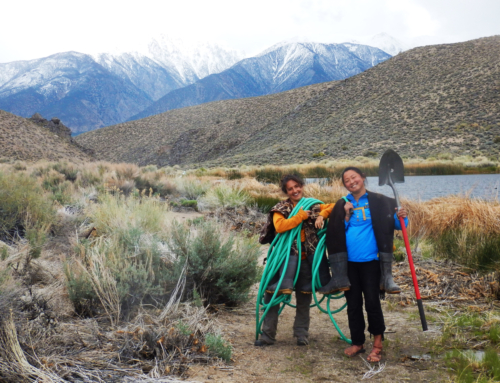Have you ever wondered what wildlife might be doing when you aren’t looking? Eastern
Sierra Land Trust set out to learn more this year and “capture” some of the wild visitors and residents of
the important and diverse area known as the Round Valley mule deer migration corridor. With a small
grant from the Norcross Wildlife Foundation, ESLT purchased a motion sensor activated camera and
stationed it for weeks at a time on conservation easement properties and public lands located within
this rich wildlife habitat. Over a period of five months, ESLT documented 15 different species with this
camera, ranging from the tiny deer mouse to the tawny mountain lion.
Wildlife migration corridors are defined as historic routes that many different wildlife species use to
travel between different types of crucial habitats. Commonly, migration corridors link winter ranges
where wildlife can avoid deep snow and find food to summer ranges where wildlife breed, give birth,
and regain strength by consuming abundant plants or other nourishment. A diversity of healthy habitats
and wide open spaces ensure that wildlife can find mates, food, and room to roam. Locally, migration
corridors in the Eastern Sierra are used by insects such as monarch butterflies, large mammals who
travel long distances such as mule deer, small mammals such as silver-haired bats, and many bird
species such as osprey, American robin, rufous hummingbird, and Western bluebirds.
Many wildlife species may reside within a migration corridor and spend their whole lives there. They
may have a small range such as a black-tailed jack rabbit or sagebrush lizard. The grey fox spends its life
in a small two-mile diameter home range, living opportunistically on wild fruit, insects, reptiles, and
rodents. Black bears living in the wild are active in summer and fall, often traveling miles a day in a food
gathering circuit.
Migration has been called a “spectacular biological event” with even greater ecological significance.
Wildlife migration corridors provide many benefits to wildlife: access to snow free habitat, linkages to
mating and birthing grounds, and a better chance at survival through connections to a larger gene pool.
Scientists are finding that fencing, highways, housing developments, energy development, wind
turbines, and climate change threaten this amazing phenomenon. Here on the wild side of California,
wildlife migration may not be completely secure but we’re lucky to have many interesting and beautiful
animals utilizing the special habitats of our local migration corridors. Check out www.eslt.org for a
photo gallery of wildlife species “captured” this year…





